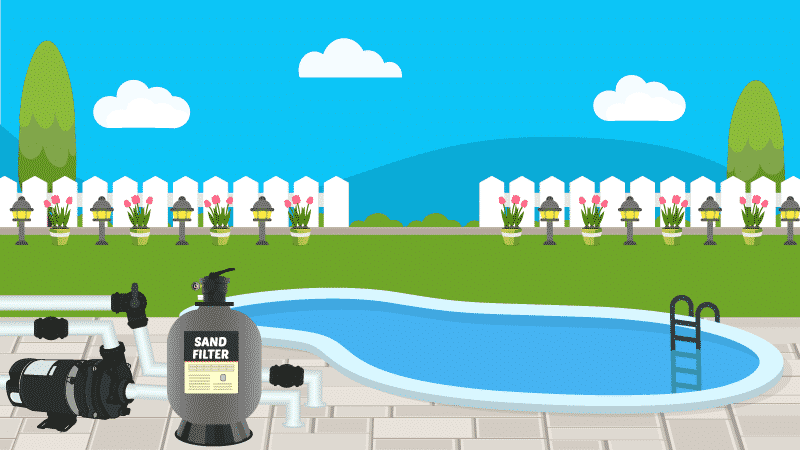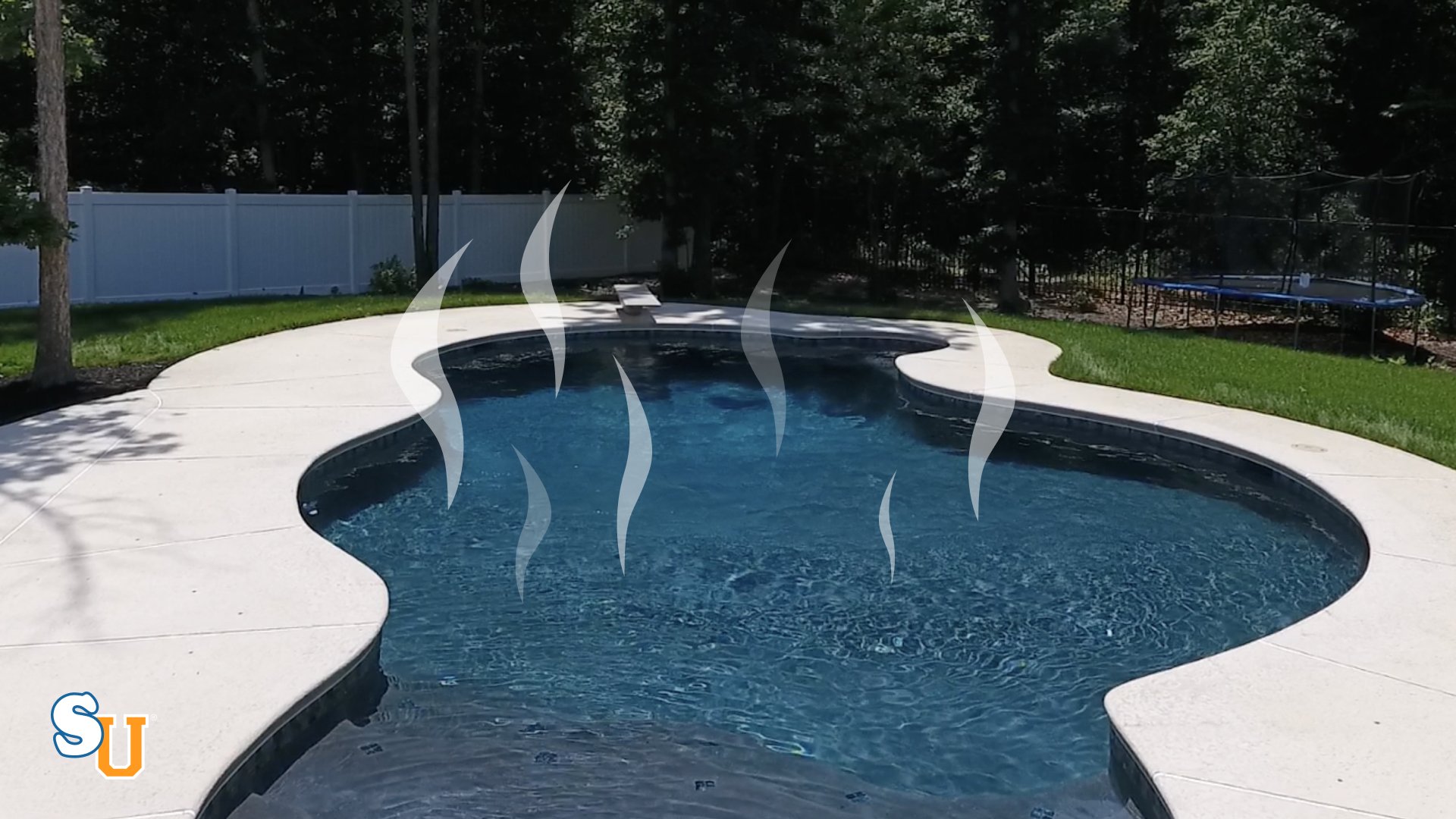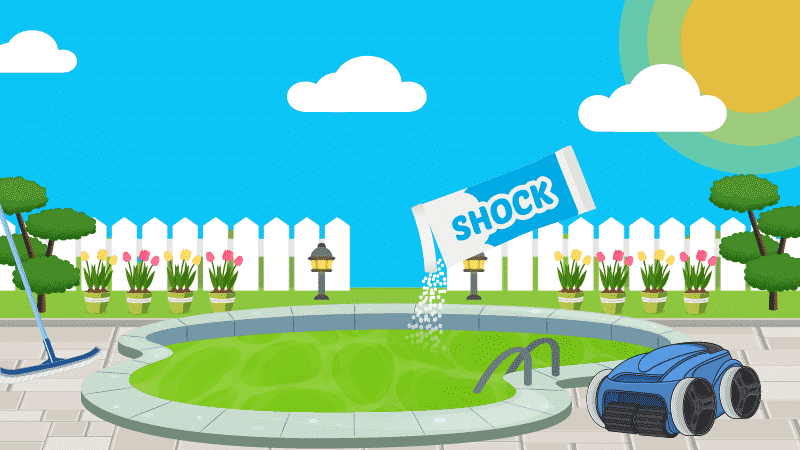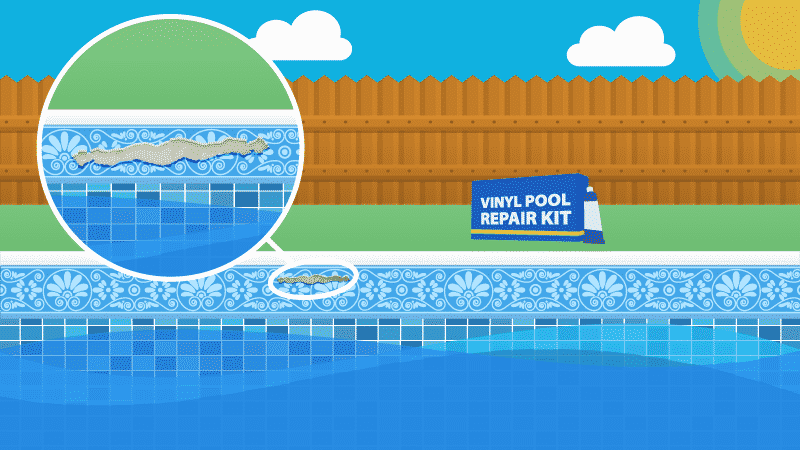How to Drain Water from Your Pool after Rain
The truth is, a rainstorm—or several small, light showers—can affect your pool chemistry, and even the equipment if the dirt and debris blown into the pool during a storm isn’t immediately addressed.
Of course, you already know how to clean your pool. But you also need to know how to drain water from your pool after rain to keep the water clean, and protect your pool and its equipment.
Should You Drain Water from Your Pool after Rain?
It’s everyone’s favorite answer: It depends.
Was it just a light sprinkling or a short rainshower? Then you probably don’t need to drain any water from the pool. It’s a good idea to test the water, though, and make sure it’s still balanced. If anything’s off, adjust as necessary.
But if you had a major thunderstorm that released a deluge into your pool, to the point where the skimmers aren’t even visible above the water line, and water may even be slopping out onto the deck, then yes. You definitely need to get some of that water out of there.
That much water added to your pool has no doubt diluted the chemicals you’ve added, and thrown the alkalinity, pH, sanitizer, and other levels out of whack.
And if the skimmers are covered by a high water line, debris like leaves and twigs—which very likely fell into your pool during the storm—can’t make their way into the skimmer baskets. They’ll stay in the water instead, endlessly floating around until enough water is removed to allow the skimmers to function properly.
Once the weather has cleared, it’s time to get some of that water out of the pool.
How to Drain Water from Your Pool after Rain
This is actually a pretty straightforward and simple process. It’s just a matter of performing these steps in the proper order for maximum efficiency and effectiveness.
1. Clean the Pool Deck
Sweep up debris from the pool deck, and use a garden hose to clean it of dirt. Be sure to sweep and spray away from the pool to prevent any debris from getting into the water.
2. Manually Remove Debris from the Pool
Attach a leaf net or flat skimmer to your telescopic pole and remove all the leaves, twigs, and other debris from the water’s surface.
If leaves, twigs, and other debris have accumulated inside the skimmer and pump baskets, the filtration system won’t work properly when you turn it on. Use a pool skimmer—or your hands, if necessary—to get everything out of the baskets as well.
It's a deep and durable leaf net pool skimmer that can collect a lot of debris all in one skimming. It also includes a lifetime guarantee. This is what the pros use!
3. Turn On the Pump and Filter
You want to get the water circulating again to remove all the contaminants too-small-for-the-skimmer bits of debris the rain introduced into your pool.
Note: If you’ve lost power due to the storm, you’ll obviously have to wait to do this step. But you still want to manually remove all the debris you can. If you leave it too long, it’ll sink to the bottom of the pool, and you’ll have a lot more vacuuming to do later.
4. Brush the Pool
Use a good pool brush to move dirt and debris away from your pool’s steps and ladder(s). If there’s a drain at the bottom of the pool, push the debris toward it.
The wide pool brush with 360-degree reach helps clean hard-to-reach surfaces and tough crevices. Perfect for any type of pool, including vinyl liners, fiberglass, and painted concrete.
5. Vacuum the Pool
If there’s not a lot of debris at the bottom of the pool, you can turn your automatic pool cleaner loose and let it do the work for you.
If there is a lot of debris—or you don’t have an automatic cleaner—you’ll have to manually vacuum the pool.
Be sure to turn your filter to “waste” before you start vacuuming. This will keep the debris from entering your filter, and will drain some of that extra water from the pool.
Continue vacuuming until all the debris is removed and the waterline reaches the halfway point on the skimmer plate, which should be about six to eight inches from the top of the pool.
If the water line reaches the desired level, but there’s still debris to vacuum, turn on your garden hose and place it in the pool to maintain the water level while you finish cleaning.
6. Drain Some of the Water from the Pool
If there’s a lot of water in your pool, but not a lot of debris, and vacuuming the small amount of debris to waste won’t remove enough of the water, you have a couple of options.
You can continue to vacuum to waste until you’ve removed enough water from the pool. Again, the goal is the halfway point on the skimmer plate, or about six to eight inches from the top of the pool.
Or, you can stop vacuuming, keep the filter turned to “waste,” connect a backwash hose to the filter’s waste port, and turn the pump on. Pump out water until the waterline reaches the desired level.
You can also use a sump pump attached to a garden hose.
7. Test and Balance the Water
A lot of rain and organic debris will likely have affected your pool’s chemistry. Use test strips or a liquid test kit to test and then balance the water.
Pay special attention to the pH, which may have dropped considerably due to the rain, especially if the rain itself was at all acidic. Remember that if the pH was drastically affected, it’s likely the alkalinity was as well. So make sure you test both.
Tests for 7 important chemistries in seconds: Total Hardness, Total Chlorine, Total Bromine, Free Chlorine, pH, Total Alkalinity, and Cyanuric Acid.
Also, check the chlorine level. Rain will often introduce contaminants to the water, and when the sanitizer starts fighting them off, the amount of available sanitizer (known as free chlorine) will drop, leaving your pool vulnerable.
Finally, check the calcium and cyanuric acid levels. These may have been diluted by the rain. Soft water can cause problems for your pool and equipment, and too little cyanuric acid will mean the chlorine isn’t stabilized, which will affect its performance.
You may want to have the water tested by a professional, or at your local pool store, just to be on the safe side. you don’t want to end up with a green or cloudy pool from the storm.
Should You Shock Your Pool after a Rainstorm?
We’re seldom going to say you shouldn’t shock your pool. It’s not absolutely necessary to shock it after rain, but it’s not a bad idea either.
Now that you know how to drain water from your pool after rain, just be sure to do that first, then balance the water, then shock. Remember to wait until dusk before adding any pool shock.
This fast-acting, quick-dissolving swimming pool shock kills bacteria, controls algae, and destroys organic contaminants in pools.
How to Prepare Your Pool for a Rainstorm
You can save yourself some work after the rain has passed if you take some time to prepare your pool before it gets there.
Store Outdoor Furniture Indoors
Remove anything that isn’t secured. This will keep it from falling into your swimming pool if the wind is strong enough to move it. This includes:
- patio furniture
- grills and smokers
- lounge chairs and cushions
- potted plants
- decorative landscaping items, like lawn gnomes (Don’t leave those little guys out in the rain!)
Important: Do NOT put your patio furniture in the pool to protect it from the storm. You may have heard this advice a time or two, but it’s not safe for your pool structure or pool water, not to mention your furniture.
Store Pool Accessories Indoors
Collect anything lying in or around the pool, and put it in a storage shed or your garage. This will keep it from ending up in your neighbor’s yard in strong winds. This includes:
- pool floats
- toys and games
- maintenance equipment, such as skimmers, poles, an automatic pool cleaner, etc.
Disconnect All Electrical and Gas Lines to Your Pool
Take special care to properly shut off all the gas lines to minimize the risk of a gas leak if the storm hits your home pretty hard.
Also, turn off the pump. If you have a timer installed, check to make sure the timer won’t kick the pump and filter back on in the middle of the storm.
If you have covers for your pump, filter, and heater, use them.
Prepare the Pool Water
Balance the water and maybe even add a little algaecide (optional). This will help fight off many of the organic contaminants that are brought in by rainwater and make it easier to clean your pool after the storm.
Optional: A properly installed pool is equipped with overflows designed to drain excess water. However, you can lower the pool by about a foot in anticipation of it being overfilled by rainwater.
Important: Do not lower the water level by any more than about a foot. If you lower it any more than that, the hydrostatic pressure generated by a rainstorm could be too much for the pool, and could cause it to pop out of the ground.
Safety First!
While we’re on the subject of pools and rainstorms, we’d like to remind you that electricity and water don’t mix. This also applies to lightning.
Even if you haven’t seen any lightning, it doesn’t mean there won’t be any. Stay out of the pool until the rain has passed.
You Can Swim Safely Now, the Rain Is Gone
Being ready for bad weather, and knowing how to drain water from your pool after rain will help you keep your pool clean, healthy, and swimmable. If you’re prepared, you can get back to enjoying your pool in no time.
Happy Swimming!
3 Ways We Can Help With Your Pool
- The Pool Care Handbook: An illustrated guide to DIY pool care, including water chemistry, maintenance, troubleshooting, and more.
- The Pool Care Video Course: You’ll get 30+ step-by-step videos and a downloadable guide with everything you need to know about pool maintenance.
- The Pool Care App: Enter your water test results. Get a custom treatment plan. Know exactly what chemicals to add to keep your pool clear.
















